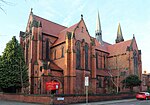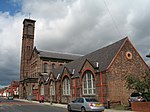Toxteth Park Cemetery
1856 establishments in EnglandAnglican cemeteries in the United KingdomCemeteries in LiverpoolCommonwealth War Graves Commission cemeteries in EnglandGrade II listed buildings in Liverpool ... and 1 more
Grade II listed parks and gardens in Merseyside

Toxteth Park Cemetery is a graveyard on Smithdown Road, Liverpool, United Kingdom. It was opened on Monday 9 June 1856. It was the responsibility of the Toxteth Park Burial Board, which had been established by at least 1855.The opening ceremony was performed by the then Lord Bishop of Chester, and the first interment took place, that of an Elizabeth Watling on 17 June 1856. The cemetery was built with consecrated and unconsecrated areas, and the layout, featuring walks, was by a "Mr Gay of Bradford cemetery".It was taken over by Liverpool Corporation on 1 January 1905.
Excerpt from the Wikipedia article Toxteth Park Cemetery (License: CC BY-SA 3.0, Authors, Images).Toxteth Park Cemetery
Hartington Road, Liverpool Wavertree
Geographical coordinates (GPS) Address Nearby Places Show on map
Geographical coordinates (GPS)
| Latitude | Longitude |
|---|---|
| N 53.393661 ° | E -2.942074 ° |
Address
Hartington Road
Hartington Road
L8 0SF Liverpool, Wavertree
England, United Kingdom
Open on Google Maps








